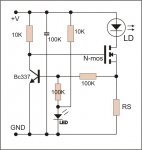- Joined
- Dec 7, 2010
- Messages
- 9
- Points
- 0
^
Just for curiosity, what are you using as Rsense ? ..... the current shunt of the amperometer ? (at those currents is the more cheap solution, usually)
im using two 50watt 0.01 ohm power resistors in parallel ( 0.005ohm ). i think cheap solutions are generally more expensive than expensive solutions...






